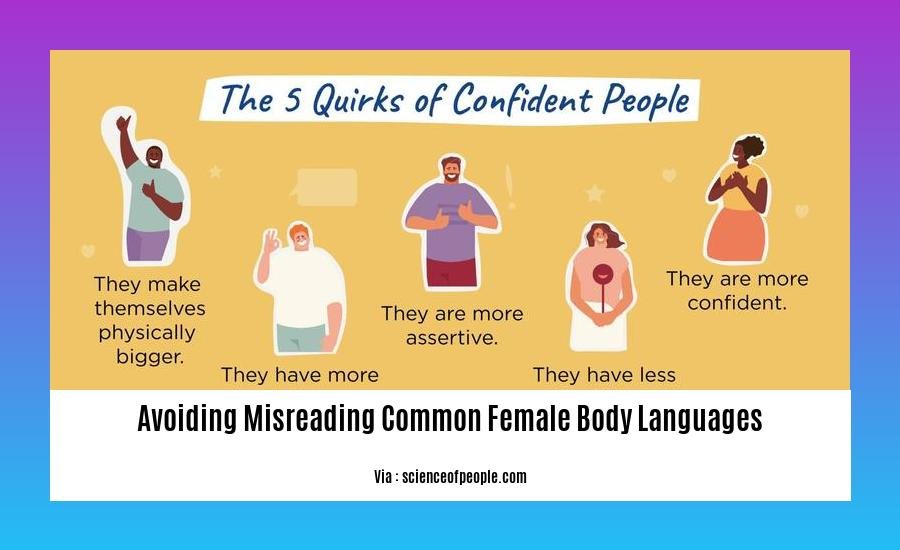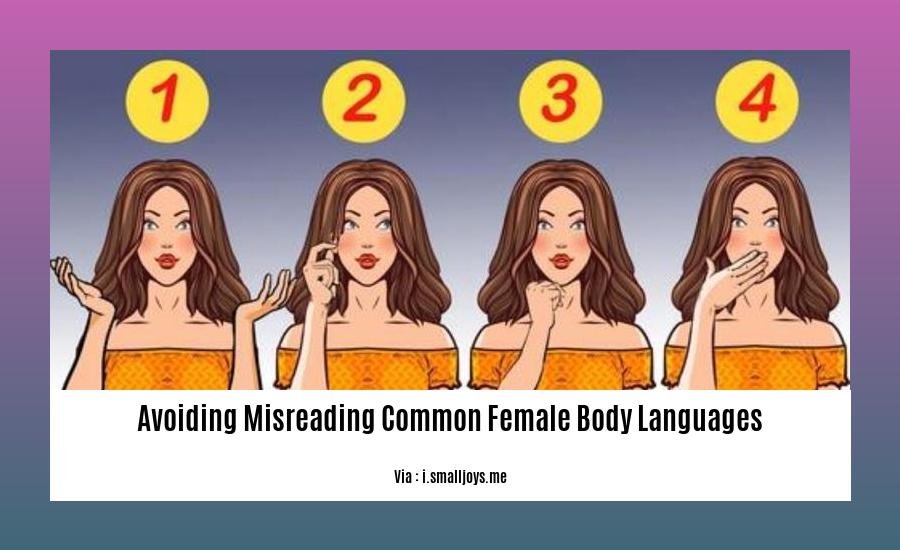**Avoiding Misreading Common Female Body Languages: Deciphering the Subtleties for Clear Communication**

Key Takeaways:
- Unconscious body language can influence perceptions and self-judgments.
- Smiles can convey discomfort, especially in women.
- Cultural differences impact the interpretation of body language.
- Anxiety and neurological variations can affect body language understanding.
- Confirmation bias can lead to inaccurate interpretations.
- Lack of eye contact does not necessarily indicate deception; it may reflect cultural norms or disrespect.
Avoiding Misreading Common Female Body Languages: A Guide to Clear Communication
Understanding Female Body Language
Communicating effectively with women involves deciphering the nuances of their body language. However, misinterpretation is common. Let’s explore some common pitfalls and how to avoid them.
Facial Expressions:
- Smiling: Don’t assume a smile always conveys happiness or friendliness. It can also mask discomfort or nervousness.
- Direct Eye Contact: While often interpreted as confidence, it may also be perceived as aggression or disrespect in certain cultures.
Body Postures:
- Open Arms: Not necessarily inviting, can also indicate vulnerability or a need for space.
- Crossed Arms: Often interpreted as defensiveness, but may simply indicate comfort or a barrier against cold.
Gestural Cues:
- Playing with Hair: A sign of flirtation? Not always. It can also be a nervous habit or a way to manage stress.
- Hand Gestures: Pay attention to context. Aggressive hand gestures can convey excitement, while timid ones may indicate insecurity.
Additional Tips:
- Contextualize: Consider the situation, surroundings, and overall tone of the conversation.
- Avoid Stereotyping: Female body language varies widely and is influenced by cultural, personal, and situational factors.
- Seek Feedback: If unsure, ask for clarification or seek trusted feedback from friends or colleagues.
- Practice Active Listening: Pay attention not just to words but also to body language, allowing for a more comprehensive understanding.
- Be Respectful: Recognize that body language is complex and can be easily misunderstood. Avoid judgments and approach interactions with empathy and open-mindedness.
If you’d like to avoid common misinterpretations of women’s body language, then you should understand the mistakes when reading her physical cues. That way, you can avoid misunderstanding her gestures and her true intentions.
More articles by this author
Unveiling the intricate nuances of nonverbal communication, particularly female body language, requires a keen eye and a deep understanding of the cultural context. To avoid misinterpretations, it’s crucial to challenge common misconceptions and embrace a holistic approach to decoding these subtle cues.
Remember, body language is not a universal language. Cultural norms and societal expectations can significantly shape how women express themselves nonverbally. Being mindful of these differences is essential for accurate interpretation.
Key Takeaways:
- Cultural Context Matters: Understand the cultural background of the individual to interpret body language accurately.
- Nonverbal Cues Can Be Complex: Avoid making assumptions based on isolated gestures. Consider the context and multiple cues together.
- Subtleties Hold Significance: Pay attention to subtle shifts in facial expressions, eye contact, and body movements.
- Nonverbal Communication Can Be Misleading: Be cautious of relying solely on nonverbal cues. Consider verbal and contextual factors as well.
- Practice Active Observation: Engage in intentional observation to develop your ability to interpret body language effectively.
Relevant URL Source:
- [Bullock, A. (2023). Four Misconceptions About Nonverbal Communication.

FAQ
Q1: How can I stay updated on the latest developments in nonverbal communication research?
A1: Regularly attend conferences, read academic journals, and follow experts in the field on social media and other platforms.
Q2: What are some common misconceptions about female body language?
A2: Misconceptions include the belief that female body language is always universally interpreted, that it is always honest, that it is always conscious, and that extroverts are always better at nonverbal communication.
Q3: How can I avoid misinterpreting female body language?
A3: Be aware of cultural differences, consider the context and overall demeanor of the individual, and avoid making assumptions based on isolated gestures or expressions.
Q4: What are some tips for effectively communicating with women?
A4: Pay attention to both verbal and nonverbal cues, ask clarifying questions, and be respectful and considerate of the other person’s perspective.
Q5: How can I improve my nonverbal communication skills?
A5: Practice active listening, maintain eye contact, use appropriate gestures and facial expressions, and be mindful of your body posture and tone of voice.










